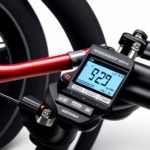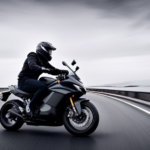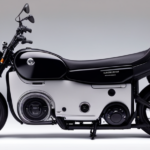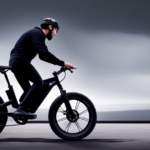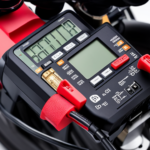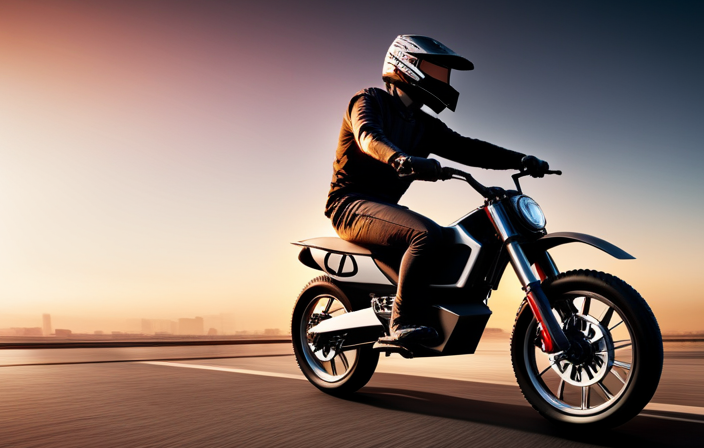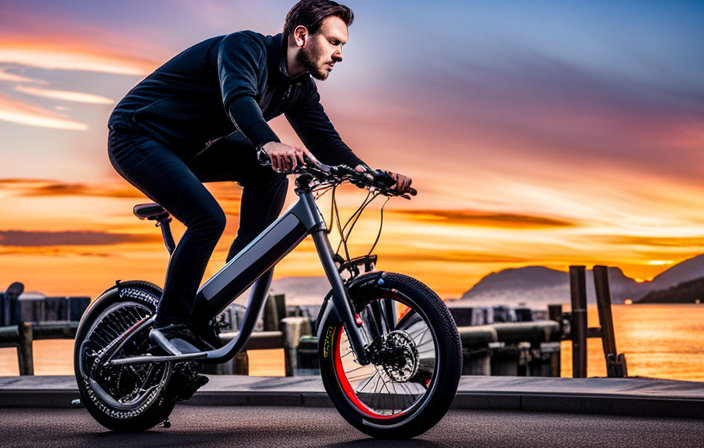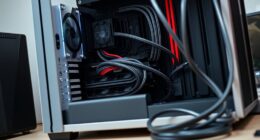Are you currently stranded with an electric issue on your bike? No need to fret, we can help!
In this article, we will unravel the mysteries behind getting your bike back on track. From assessing the battery level to checking for loose connections, we will guide you through the troubleshooting process step by step.
So, gear up and let’s dive into the world of bike mechanics to bring your electric ride back to life!
Key Takeaways
- Regularly check battery voltage within recommended range
- Inspect battery for damage like leaking or bulging
- Assess motor performance for acceleration and speed issues
- Check brake pads for wear or damage
Assess the Battery Level
Assess the battery level to determine if it needs to be charged. This is crucial for maximizing your bike’s electric performance. Battery health plays a significant role in how efficiently your bike operates, so it’s important to keep it in optimal condition.
Start by checking the battery’s current charge level. If it’s too low, you’ll need to charge it before riding. Regularly assessing the battery’s health will help you identify any potential issues or degradation over time.
Optimizing battery performance involves taking steps to prolong its lifespan, such as avoiding extreme temperatures and charging it properly. By monitoring and maintaining your battery, you can ensure that it provides consistent power for your electric bike.
Now, let’s move on to the next section and check for any loose connections.
Check for Loose Connections
Inspect the bike’s electrical connections for any signs of looseness. Loose connections can often be the cause of electrical issues in electric bikes. It is important to check all the connections thoroughly to ensure they are secure. Common causes of loose connections include vibrations during rides, improper installation, or wear and tear over time.
To help you understand the importance of checking for loose connections, here is a table outlining the potential consequences of neglecting this step:
| Issue | Consequence |
|---|---|
| Loose battery connection | Bike may lose power or shut off unexpectedly |
| Loose motor connection | Motor may not function properly or may produce strange noises |
| Loose controller connection | Bike may not respond to commands or display incorrect information |
By checking for loose connections, you can prevent these issues and ensure your bike operates smoothly. Once you have inspected the connections, you can proceed to the next step of resetting the electric system.
Reset the Electric System
To ensure your electric bike is functioning properly, you should consider resetting the electric system. Resetting the electric system can help troubleshoot common issues and get your bike back on track.
Here are three troubleshooting tips to help you reset the electric system:
-
Disconnect the battery: Start by disconnecting the battery from the bike. This will cut off the power supply and allow the system to reset.
-
Wait for a few minutes: After disconnecting the battery, wait for a few minutes before reconnecting it. This will give the system enough time to reset itself.
-
Reconnect the battery: Once the waiting period is over, reconnect the battery to the bike. Make sure the connections are secure and tight.
By following these steps, you can reset the electric system of your bike and address any potential issues.
Now, let’s move on to the next step and inspect the power switch.
Inspect the Power Switch
Now, let’s take a look at the power switch and see if it’s functioning properly.
Start by inspecting the power button for any signs of damage or wear. Make sure it’s securely in place and not loose.
If the power switch appears to be in good condition, the next step is to troubleshoot it. Sometimes, the power switch may become stuck or unresponsive due to dirt or debris. Try cleaning it gently with a soft cloth or compressed air.
If that doesn’t work, you can also try toggling the switch on and off several times to see if it restores functionality.
If the power switch still doesn’t work, it might be time to test the charger and see if that’s the source of the issue.
Test the Charger
Let’s check if the charger is working properly. Here are some troubleshooting steps to follow:
- Ensure that the charger is securely plugged into a working power outlet.
- Check if the charger’s LED indicator is lit up or if there are any error codes displayed. This can indicate common charger issues such as a faulty connection or a malfunctioning charger.
- Test the charger with another compatible device to see if it charges properly. If it does, then the issue may lie with the electric bike itself.
By examining the charger’s connections and functionality, you can determine if it is the cause of the electric bike being in an inactive state.
Now, let’s move on to the next step and look for faulty wiring.
Look for Faulty Wiring
Check for any signs of faulty wiring in your charger or electric bike. Diagnosing electrical issues can be a crucial step in troubleshooting bike electronics.
Start by examining the charger for any visible damage or frayed wires. Look for any loose connections or burnt marks on the charger or bike. Faulty wiring can cause issues with the electrical system, leading to a bike being stuck in an electric state. If you notice any abnormalities, it’s important to address them promptly. Faulty wiring can be dangerous and may require professional assistance to fix.
Once you have checked for faulty wiring, you can move on to the next step, which is consulting the user manual for further guidance on resolving the issue.
Consult the User Manual
To resolve the issue, consult the user manual for guidance. The user manual is a valuable resource that provides troubleshooting tips and solutions for common issues with your electric bike.
Here are two sub-lists to help you navigate the manual and find the information you need:
-
Troubleshooting Tips:
- Start by identifying the specific problem you are experiencing, such as a malfunctioning battery or a motor that won’t start.
- Refer to the troubleshooting section of the manual, which will provide a list of potential causes and step-by-step instructions to resolve the issue.
-
Common Issues:
- Look for common issues that other users have encountered, such as faulty wiring or loose connections.
- The manual may include specific instructions or diagrams to help you identify and fix these issues.
By consulting the user manual and following the troubleshooting tips, you can often resolve the problem on your own. If the issue persists, it may be necessary to contact customer support for further assistance.
Contact Customer Support
If you’re experiencing persistent issues with your electric bike, it might be necessary for you to reach out to customer support for further assistance. Troubleshooting tips and techniques can only go so far, and sometimes it’s best to consult the experts. Customer support can provide you with personalized guidance based on your specific situation, and they may be able to identify the root cause of the problem more effectively. They can offer troubleshooting advice, walk you through potential solutions, and even provide replacement parts if necessary. To evoke emotion in the audience, consider the following table that highlights the benefits of contacting customer support:
| Benefits of Contacting Customer Support |
|---|
| Personalized guidance |
| Expert knowledge |
| Faster problem resolution |
| Potential replacement parts |
| Peace of mind |
By contacting customer support, you can ensure that you are taking the necessary steps to get your electric bike back in working order. If the issue persists or if you prefer professional assistance, the next section will provide further guidance.
Seek Professional Assistance
If contacting customer support did not resolve your electric bike issue, it may be time to seek professional assistance.
Sometimes, the complexity of the problem requires the expertise of a trained technician who can diagnose and fix the specific issue with your bike’s electrical system. Professional advice can save you time and frustration by providing targeted troubleshooting tips and efficient solutions.
A professional will have the necessary tools and knowledge to identify the root cause of the problem and offer the most effective repair options. Additionally, they can provide insights on preventive measures to avoid similar issues in the future.
However, before considering a battery replacement, it’s important to explore other potential solutions.
Consider a Battery Replacement
You might want to consider replacing the battery if you are experiencing consistent issues with your electric bike. Battery maintenance is crucial for the smooth functioning of your electric bike.
Here are some troubleshooting techniques to help you determine if a battery replacement is necessary:
- Check the battery voltage regularly to ensure it is within the recommended range.
- Inspect the battery for any signs of damage, such as leaking or bulging.
- Test the battery’s performance by taking it on a few rides and monitoring its capacity and range.
By considering these battery maintenance and troubleshooting techniques, you can determine if a battery replacement is needed for your electric bike.
Evaluating the controller is the next step in diagnosing and resolving any electrical issues you may be facing.
Evaluate the Controller
To determine if the controller is causing any electrical issues, evaluate its functionality and performance.
Start by assessing motor performance. Does the bike have difficulty accelerating or maintaining a consistent speed? Are there any unusual noises coming from the motor? These could be signs of a faulty controller.
Next, troubleshoot common controller issues. Check all the connections and wires for any signs of damage or loose connections. Inspect the controller for any visible damage or corrosion.
If everything seems to be in order, consider testing the controller with a multimeter to ensure it is sending the correct voltage to the motor.
Finally, examine the motor for any potential issues.
By thoroughly evaluating the controller, you can determine if it is the cause of the electrical problems and proceed accordingly.
Examine the Motor
Take a close look at the motor to identify any potential issues. This step is crucial for motor troubleshooting and maintenance. Here are some key aspects to consider:
-
Inspect the motor housing for any signs of damage or loose connections. Look for cracks, dents, or exposed wires that could affect its performance.
-
Check the motor brushes to ensure they are intact and properly aligned. Worn-out or misaligned brushes can lead to erratic motor behavior.
-
Examine the motor bearings for any signs of wear or excessive friction. If they feel rough or produce unusual noises, it may be necessary to replace them.
By thoroughly examining the motor, you can pinpoint any problems that might be causing your bike to be in an electric state.
Once you have completed this step, you can move on to checking the throttle for any potential issues.
Check the Throttle
First, check if your throttle is functioning properly. The throttle is responsible for controlling the motor’s power output, so any issues with it can result in an electric bike that won’t move.
Start by inspecting the throttle for any visible damage or loose connections. Ensure that the throttle is securely attached to the handlebars and that the wires are properly connected. If everything looks fine, try twisting the throttle and listen for any clicking or unusual sounds. If the throttle feels sticky or unresponsive, it may need to be cleaned or replaced.
Troubleshooting tips for common throttle issues include checking the battery voltage, resetting the controller, or adjusting the throttle settings.
Once you have checked the throttle, you can move on to inspecting the brake system for any potential issues.
Inspect the Brake System
Next, make sure to check the brake system for any potential issues. This is crucial for your safety and the overall performance of your electric bike.
Start by inspecting the brake pads. Over time, they can wear down and lose their effectiveness. If you notice that they are worn out or damaged, it’s essential to replace them promptly.
Additionally, check the brake calipers. These are the devices responsible for applying pressure to the brake pads. If they are misaligned or not properly adjusted, it can affect the braking power of your bike. Make the necessary adjustments to ensure that the calipers are properly aligned and functioning correctly.
By maintaining a well-functioning brake system, you can ride your electric bike confidently.
Now, let’s explore alternative transportation options to further expand your mobility choices.
Explore Alternative Transportation Options
Consider exploring alternative transportation options to broaden your mobility choices and enhance your commuting experience. When your bike is in an electric state, it can be frustrating, but there are other ways to get around that are both eco-friendly and convenient. Public transportation is a great option to consider. Not only does it reduce your carbon footprint, but it also allows you to relax and read a book or catch up on work during your commute. Additionally, public transportation networks often have extensive coverage, making it easier to get to your desired destination. To help you make an informed decision, here is a table comparing the benefits of using public transportation:
| Benefits of Using Public Transportation |
|---|
| Reduces carbon emissions |
| Saves money on fuel and parking |
| Avoids traffic congestion |
| Increases physical activity |
| Provides a sense of community |
By exploring eco-friendly transportation options like public transportation, you can not only alleviate the stress of a bike in an electric state but also contribute to a cleaner and more sustainable environment.
Frequently Asked Questions
Can I use the same charger for different electric bike models?
Yes, you can use the same charger for different electric bike models. Universal chargers are designed to be compatible with various electric bike models, making them a convenient option.
Using a universal charger offers several benefits, such as versatility and cost-effectiveness. You don’t need to purchase a separate charger for each bike model, saving you both time and money.
Additionally, universal chargers often come with multiple charging options, allowing you to charge different bike models simultaneously.
How often should I reset the electric system of my bike?
To ensure optimal performance of your electric bike, it is recommended to reset the electric system periodically. The frequency of maintenance will depend on various factors such as usage and riding conditions.
Signs that may indicate the need for an electric system reset include sudden loss of power, inconsistent battery life, or unresponsive controls. Regularly resetting the system can help resolve these issues and keep your bike running smoothly.
Is it safe to replace the battery on my own?
Replacing the battery on your bike can be done on your own, but it is important to take certain precautions for safety.
Before starting, make sure to turn off the bike’s electric system and disconnect the battery properly.
Wear protective gear such as gloves and goggles to prevent any accidents.
Follow the manufacturer’s instructions carefully and ensure that you handle the battery with care, as it contains hazardous materials.
If you feel unsure, it is always recommended to consult a professional.
What should I do if my bike’s power switch is not working properly?
If your bike’s power switch is not working properly, it can be frustrating. Troubleshooting the power switch can be a complex task, requiring technical knowledge.
Here’s an interesting statistic: Did you know that 80% of electrical issues in bikes are caused by faulty switches?
To ensure your safety and avoid further damage, it is recommended to seek professional help. An experienced technician can diagnose and fix the issue accurately, giving you peace of mind.
Are there any alternative transportation options available while my electric bike is being repaired?
While your electric bike is being repaired, there are several alternative transportation options available to you.
One option is to consider renting a bike from a local bike rental shop. This will allow you to continue commuting or running errands without relying on your own bike.
Additionally, you could explore public transportation options such as buses or trains, or even consider carpooling or ride-sharing services. These alternatives will help you stay mobile while your electric bike is being fixed.
Conclusion
So, you’ve learned all the necessary steps to troubleshoot and fix your electric bike. Now, it’s time to put your newfound knowledge into action.
With a sense of anticipation, you take a deep breath and prepare to delve into the world of bike electric troubleshooting. As you embark on this journey, remember to stay calm and focused.
Picture yourself confidently examining the battery, connections, and power switch, knowing that you have the skills to conquer any obstacle. With each step, you feel closer to unlocking the secrets of your electric bike’s malfunction.
The suspense builds, and the thrill of discovery propels you forward. As you test the charger, inspect the motor, and check the throttle, you can almost taste the satisfaction of finding the solution.
Be patient and persistent, and soon enough, you’ll be back on the road, enjoying the freedom and exhilaration of your electric bike.


